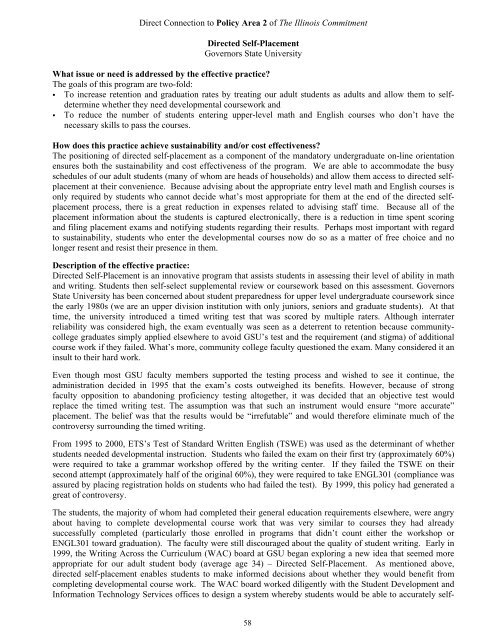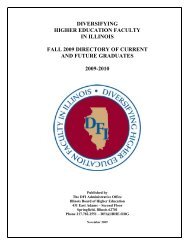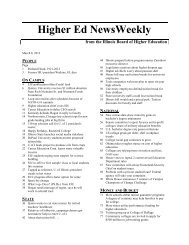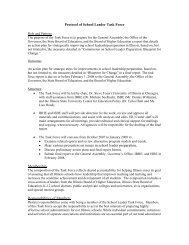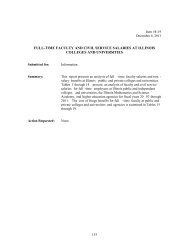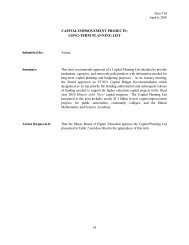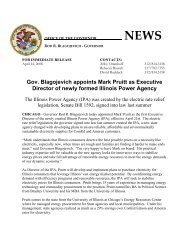Title of Effective Practice: - California Postsecondary Education ...
Title of Effective Practice: - California Postsecondary Education ...
Title of Effective Practice: - California Postsecondary Education ...
You also want an ePaper? Increase the reach of your titles
YUMPU automatically turns print PDFs into web optimized ePapers that Google loves.
Direct Connection to Policy Area 2 <strong>of</strong> The Illinois Commitment<br />
Directed Self-Placement<br />
Governors State University<br />
What issue or need is addressed by the effective practice?<br />
The goals <strong>of</strong> this program are two-fold:<br />
• To increase retention and graduation rates by treating our adult students as adults and allow them to selfdetermine<br />
whether they need developmental coursework and<br />
• To reduce the number <strong>of</strong> students entering upper-level math and English courses who don’t have the<br />
necessary skills to pass the courses.<br />
How does this practice achieve sustainability and/or cost effectiveness?<br />
The positioning <strong>of</strong> directed self-placement as a component <strong>of</strong> the mandatory undergraduate on-line orientation<br />
ensures both the sustainability and cost effectiveness <strong>of</strong> the program. We are able to accommodate the busy<br />
schedules <strong>of</strong> our adult students (many <strong>of</strong> whom are heads <strong>of</strong> households) and allow them access to directed selfplacement<br />
at their convenience. Because advising about the appropriate entry level math and English courses is<br />
only required by students who cannot decide what’s most appropriate for them at the end <strong>of</strong> the directed selfplacement<br />
process, there is a great reduction in expenses related to advising staff time. Because all <strong>of</strong> the<br />
placement information about the students is captured electronically, there is a reduction in time spent scoring<br />
and filing placement exams and notifying students regarding their results. Perhaps most important with regard<br />
to sustainability, students who enter the developmental courses now do so as a matter <strong>of</strong> free choice and no<br />
longer resent and resist their presence in them.<br />
Description <strong>of</strong> the effective practice:<br />
Directed Self-Placement is an innovative program that assists students in assessing their level <strong>of</strong> ability in math<br />
and writing. Students then self-select supplemental review or coursework based on this assessment. Governors<br />
State University has been concerned about student preparedness for upper level undergraduate coursework since<br />
the early 1980s (we are an upper division institution with only juniors, seniors and graduate students). At that<br />
time, the university introduced a timed writing test that was scored by multiple raters. Although interrater<br />
reliability was considered high, the exam eventually was seen as a deterrent to retention because communitycollege<br />
graduates simply applied elsewhere to avoid GSU’s test and the requirement (and stigma) <strong>of</strong> additional<br />
course work if they failed. What’s more, community college faculty questioned the exam. Many considered it an<br />
insult to their hard work.<br />
Even though most GSU faculty members supported the testing process and wished to see it continue, the<br />
administration decided in 1995 that the exam’s costs outweighed its benefits. However, because <strong>of</strong> strong<br />
faculty opposition to abandoning pr<strong>of</strong>iciency testing altogether, it was decided that an objective test would<br />
replace the timed writing test. The assumption was that such an instrument would ensure “more accurate”<br />
placement. The belief was that the results would be “irrefutable” and would therefore eliminate much <strong>of</strong> the<br />
controversy surrounding the timed writing.<br />
From 1995 to 2000, ETS’s Test <strong>of</strong> Standard Written English (TSWE) was used as the determinant <strong>of</strong> whether<br />
students needed developmental instruction. Students who failed the exam on their first try (approximately 60%)<br />
were required to take a grammar workshop <strong>of</strong>fered by the writing center. If they failed the TSWE on their<br />
second attempt (approximately half <strong>of</strong> the original 60%), they were required to take ENGL301 (compliance was<br />
assured by placing registration holds on students who had failed the test). By 1999, this policy had generated a<br />
great <strong>of</strong> controversy.<br />
The students, the majority <strong>of</strong> whom had completed their general education requirements elsewhere, were angry<br />
about having to complete developmental course work that was very similar to courses they had already<br />
successfully completed (particularly those enrolled in programs that didn’t count either the workshop or<br />
ENGL301 toward graduation). The faculty were still discouraged about the quality <strong>of</strong> student writing. Early in<br />
1999, the Writing Across the Curriculum (WAC) board at GSU began exploring a new idea that seemed more<br />
appropriate for our adult student body (average age 34) – Directed Self-Placement. As mentioned above,<br />
directed self-placement enables students to make informed decisions about whether they would benefit from<br />
completing developmental course work. The WAC board worked diligently with the Student Development and<br />
Information Technology Services <strong>of</strong>fices to design a system whereby students would be able to accurately self-<br />
58


